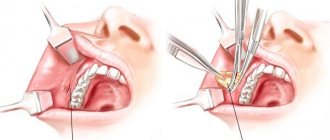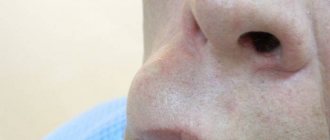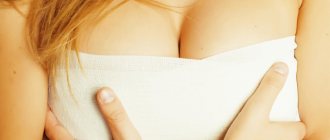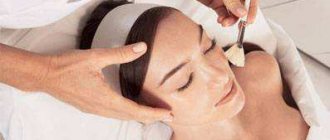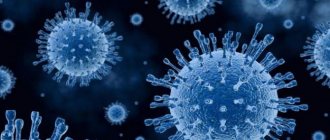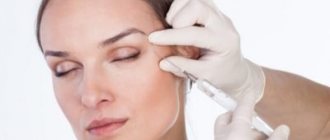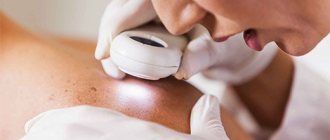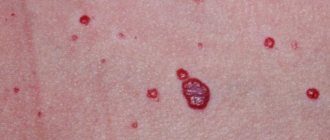A beautiful oval face without “hamster” cheeks - isn’t this what every woman dreams of? But nature has blessed few people with beautiful cheekbones and a complete absence of fat on the face. Some people turn to cosmetologists to correct their oval shape, while the more daring ones decide to undergo surgery.
Removing Bish's lumps can hardly be called a serious surgical intervention. The main thing is to get into the hands of a qualified surgeon and you will be guaranteed a beautiful oval face with sunken cheeks. However, what will happen to the face in old age, because the removal of fatty bags leads to drooping of soft tissues?! Let's look at the issue of removing Bish's lumps, as well as all sorts of emanating consequences and complications.
What are Bisha's lumps and what functions do they perform?
Bisha's lumps are two fat pads in both cheeks that help babies suckle breast milk. With age, their function is naturally lost.
Why does an adult need Bish's lumps? Some say they protect the inside of the cheeks while chewing food. However, what adult is such a clumsy chewer that he needs such protection?
Also, there is an opinion that fat packets prevent damage to the mucous membrane from the outside during facial injuries.
In fact, in adulthood, these formations are necessary for the formation of facial features and the correct oval. From the point of view of facial anatomy, sunken cheeks are pathological. Bish's lumps seem to support the tissues, preventing them from falling down.
Bisha's lumps and Robin's folds
Bichat lumps and Robin-Magiteau folds in general are a device that helps the newborn to better cover the nipple during feeding.
When sucking, the child covers the mother's nipple and the part of the areola bordering it with his lips; at the same time he lowers his lower jaw along with his tongue down. Under the influence of irritation, the nipple muscles contract, it becomes harder, thinner and somewhat lengthened.
Robin-Magiteau folds in a child contribute to a hermetic coverage of the nipple area. By moving the tongue and lower jaw in the oral cavity, the child creates a vacuum equal to 4-14 cm of water. Art. As a result of movements following one after another, the vacuum can reach 60-140 cm. Bisha's fatty lumps prevent the cheeks from pressing inward. Consequently, a closed cavity with negative pressure is obtained.
The child presses his jaws on the area of the areola, squeezes milk out of the excretory ducts of the milk passages and swallows it. One swallowing movement is preceded by several sucking movements.
Along with the milk, the baby also swallows a certain amount of air (physiological aerophagia). The entry of air into the stomach can be caused by both rapid and copious swallowing of milk and sucking on an empty breast.
Feeding in a horizontal position also contributes to aerophagia to some extent. Air swallowed by a newborn while feeding in an elevated position may rise up the esophagus into the upper part of the stomach and be released as a belch. If the air rising through the esophagus also carries away some of the milk in the stomach, then regurgitation is observed.
S. M. Becker distinguishes four phases in the act of sucking. The first phase of reception is the child’s irritation of the skin receptors of the areolar-nipple area; the second is the phase of aspiration and nipple coverage; the third is the phase of compression of the nipple, as a result of which milk is released from the mammary gland; the fourth is the phase of swallowing milk. We share the point of view of S. M. Becker on the need to highlight the reception phase in the act of breastfeeding a child. The pressure exerted by the child on the nipple is 200-300 g in a newborn and about 700-800 g in a 2-week-old child.
“Nutrition of a healthy and sick child”, B.F. Shagan
Organization of the dairy kitchen
When organizing the work of a dairy kitchen, strict adherence to the following requirements is of exceptional importance. A thorough medical examination of all applicants for work (examination by a doctor, chest x-ray, stool examination for intestinal bacilli carriage and for intestinal worms). In the future, systematic examinations of personnel: once a month a medical examination, 2 times a year chest x-ray and stool examinations...
Products in dairy kitchen
The main product used for the preparation of infant formula is cow's milk, which must come fresh and uncontaminated from healthy cows. The time from the moment of milking to the receipt of milk in the kitchen cannot exceed 24 hours. The temperature of cow's milk when delivered to the kitchen should not be higher than 10°. Milk must be delivered to the dairy kitchen in tightly closed sealed...
Reagents
Decinormal sodium hydroxide solution, amyl alcohol, sulfuric acid with a specific gravity of 1.82, phenolphthalein - 2% alcohol solution, 70% alcohol. To determine the degree of acidity of milk, the Soxhlet-Henkel device is used. If it is not available, you can use a burette with divisions attached to a tripod. A rubber tube with a clamp is placed on the narrow end of the burette, and a glass tube is placed on the free end...
Heat treatment, capping and labeling of mixtures
Before heat treatment, the milk is filtered through a double layer of gauze with a layer of cotton wool. The filtered milk is sent for processing, and the gauze that served as the filter is washed and boiled. Heat treatment of milk, mixtures and their cooling. The milk is poured into bottles, which are well sealed and heat treated in steam sterilizers or water pasteurizers (a vessel with boiling water). The steam sterilizer represents…
Nutrition of infants during surgical treatment of congenital pyloric stenosis
One of the reasons for impaired physical development of children in the first weeks and months of life is the sometimes occurring congenital pyloric stenosis. There is no doubt that the treatment of such children should be surgical. Early diagnosis and timely surgery, as well as proper preoperative preparation and postoperative management aimed at restoring water-salt and protein metabolism, preventing complications and treating concomitant diseases allow...
Who is contraindicated to remove Bish's lumps?
Bisha's lumps gradually decrease with age, so girls under 25 years old are not recommended to undergo the procedure for their removal. It is quite possible that natural regression of these formations will occur and the need for surgery will no longer be necessary.
You may be denied an operation if you have serious internal diseases that either are a contraindication to the use of anesthesia or affect blood clotting.
The procedure is contraindicated in the following cases:
- severe liver pathologies, cirrhosis;
- diabetes mellitus with uncontrolled blood sugar levels;
- decompensated heart and vascular diseases;
- hemophilia, low blood clotting;
- severe obesity or, conversely, exhaustion.
Also, surgery should not be performed in cases of exacerbation of chronic diseases, colds, or the presence of rashes, in particular, herpes on the face.
What are the consequences after removing Bisha's lumps?
The consequences after removing Bisha's lumps can be divided into inevitable and undesirable, that is, complications.
Inevitable consequences develop immediately after surgery. These include:
- swelling of the facial skin;
- bruises (when removed not through the mucous membrane);
- pain when chewing.
All this goes away within a few days as the surgical wound heals.
Undesirable consequences can be divided into:
- Early, occurring immediately or within a few days after surgery.
- Late, developing after 10 years and in old age.
LumpsBisha: how to remove fatty deposits in the cheeks without surgery at home, video
Considering the possible risks of plastic surgery, many people wonder whether it is possible to remove fat deposits (Bish’s lumps) at home. Fortunately, this is possible, but not without a lot of effort. Firstly, hypertrophy of the fat layer in the cheeks is often associated with increased body weight. Therefore, adjusting the diet and an active lifestyle help in the fight against this problem.
How to remove fat deposits in the cheeks (Bisha lumps) without surgery at home, video
Secondly, special gymnastics gives excellent results in removing fatty deposits in the cheeks. These are highly targeted exercises from the popular face-building technique, which, when performed regularly, significantly reduce Bisha's lumps without surgery. Considering that this gymnastics does not cost anything, has no disadvantages, and no negative consequences in the form of rehabilitation and swelling, as after plastic surgery, then it is simply stupid not to use it. In addition, real reviews with photos before and after such exercises prove their high effectiveness. Even screen stars who want to look impressive in old age are mastering Facebook building! Next you will find a video with simple exercises to reduce the volume of your cheeks at home.
Complications that may occur immediately after surgery
Before we deal with the long-term consequences, let's see what can happen during or immediately after the operation?
- An allergic reaction to the anesthetic, which is manifested by a drop in blood pressure, nausea, vomiting, and a rash on the body. To avoid this, the doctor will talk with you before the intervention about how you previously tolerated pain-relieving injections and, if necessary, do a skin test.
- Bleeding. This complication can develop during surgery if a large vessel is damaged or in the postoperative period if the wound is handled improperly. You may also experience bleeding if you have hemophilia or low blood clotting ability. Therefore, before the intervention, every competent doctor will order a blood test and ask about all concomitant diseases.
Important!
Choose experienced surgeons and carefully consider all the doctor’s recommendations! Remember that surgery does not allow for savings, so a competent doctor who uses high-quality materials and instruments and has undergone the necessary training cannot do it cheaper than everyone else!
Rehabilitation period
Recovery of the body after surgery lasts from 2 to 6 weeks and is determined by the method of plastic surgery, as well as the individual characteristics of each patient’s body.
So, when making an incision inside the oral cavity, it is recommended to adhere to the following general recommendations:
- Eating liquid food that does not require chewing for 3-7 days. Avoiding hard foods for up to one month.
- Following a special diet (avoiding hot, spicy, salty or overly sweet foods) during the entire recovery period.
- Limiting the consumption of meat and fish during the rehabilitation period (these categories of products can cause infection).
- Mandatory rinsing of the mouth after eating for 4-6 weeks.
It is important to follow a diet after surgery
If the operation was performed using an external method, then special attention should be paid to limiting the following external factors:
- High temperatures. You should not visit baths, saunas, steam rooms, or swimming pools.
- Mechanical pressure. It is forbidden to massage or sleep on your stomach with your face in the pillow.
Ideally, all types of recommendations should be followed, regardless of the method of intervention. It is also necessary to reduce physical activity to the maximum, do not shout, and avoid active facial movements. The treatment of sutures with antiseptic drugs and the use of painkillers should be agreed upon with the surgeon. The specialist can prescribe additional, individual rehabilitation measures for the patient.
Consequences that may appear after 10 years and in old age
In old age, the absence of fat packets leads to pronounced ptosis (drooping) of soft tissues. However, with age, oval sagging will occur in every woman, and whether the lack of fat bodies will be to blame for this is a question. By the way, for some older women, removing Bisha's lumps allows, on the contrary, to correct age-related changes.
Also, you may hear that after removing Bisha's lumps, after 10 years the skin of the cheeks becomes flabby. Some people are inclined to believe that the removal of fatty bags may be to blame, but from a medical point of view, sagging skin is caused by a reduced content of collagen and elastin, which has nothing to do with the fat cells on both sides of the cheek. In addition, Bisha's lumps increase the load on the facial muscles, which also leads to rapid aging and sagging of soft tissues.
Methods for performing the operation
Surgical intervention to eliminate Bisha's lumps is practiced quite often, takes no more than 40 minutes and can be performed both under general anesthesia and local anesthesia. The specific method of pain relief is determined by the characteristics of the patient’s body and the method of manipulation. The last factor underlies the classification of the operation, implying its division into the following two areas:
- External method . It is practiced as a complement to other types of plastic surgery, and is not used independently.
- Internal method . It is carried out separately from other types of interventions. It involves making an incision in the oral cavity, through which the lumps along with their membrane are removed.
Internal method for removing lumps of Bisha
Among other things, Bisha's lumps can not only be removed, but also change their position (movement of buccal fat to the cheekbone area).
Upon completion of the manipulations, the site of violation of the integrity of the skin or mucous membrane is secured with sutures and a bactericidal bandage. The patient can leave the clinic within 6-48 hours after the operation.
In any case, results are assessed 2-3 weeks after the intervention, as side effects decrease.
Prevention of complications. What should you pay attention to?
In order to avoid complications during and after the operation, you should properly prepare for the intervention. To do this, the doctor prescribes a series of preoperative examinations, including:
- general blood and urine analysis;
- study of liver parameters, blood sugar, bilirubin, urea.
Among the instrumental methods, fluorography and ECG are prescribed. An examination by related specialists is required: a gynecologist and a therapist. If the patient has any chronic diseases, then others may be added to these examinations to determine the state of the body’s disturbing system.
Sometimes, after removing Bisha's lumps, the cheeks become too hollow. This happens if the fat lumps are too large. To avoid this complication, before surgery the doctor carefully examines and palpates the cheek area. And some advanced centers offer computer modeling - based on the patient’s data, to build the shape of the face that will be after the operation. If necessary, fat bags can be partially removed or moved to the cheekbone area, making the face even more similar to the desired one.
Immediately after surgery, pay attention to the following restrictions and do not ignore them:
- Smoking is prohibited for 3-5 days.
- As long as there is swelling (5-7 days), do not drink hot drinks, as this will only worsen the swelling.
- Until postoperative wounds heal, avoid eating rough food, and in the first 2-3 days it is recommended to eat broth and dairy products - this way you will eliminate mechanical damage to postoperative wounds.
- Brush your teeth carefully so as not to damage the stitches.
- For the next 2 weeks, sleep exclusively on your back with a high pillow - this measure will help avoid worsening swelling after sleep.
- Hot showers, baths, baths and saunas are prohibited for 2 weeks after surgery.
- Eliminate physical and psycho-emotional stress for the next 2 weeks, and after this time, return to the normal rhythm of life gradually, do not immediately run to the gym and do your usual activities.
It is important that the doctor correctly explains to the patient what to do and how to behave. If you still have unclear points, discuss them before the operation, because after the intervention you will be able to leave the clinic in a few hours and, perhaps, you will not have the time or desire to communicate with the doctor.
If you have found an experienced plastic surgeon, have undergone a preventive examination, are aware of all the risks, and understand how to behave after the operation; For you, the question about the consequences of
removing Bish’s lumps and complications is completely clear, then you have done everything possible to protect yourself.
As for the long-term consequences, think about whether they are so important, because in old age and without this operation the face will undergo drooping, but you want to be beautiful here and now!
July 28, 2020 by anna
Stars who removed Bisha's lumps
The procedure is especially popular among foreign stars. Many people resorted to a similar procedure, and all of them were able to improve their facial features and improve their appearance:
- Victoria Beckham.
- Demmy Moor.
- Angelina Jolie.
- Megan Fox.
These are not all the stars who have undergone bishectomy, and some of them have combined the procedure with other facial plastic surgery for perfection. Celebrities often combine this procedure with a facelift, liposuction of the cheeks and chin. The effect after a complex correction procedure is noticeable, and you can see it in the photo below.
Angelina Jolie before and after surgery

